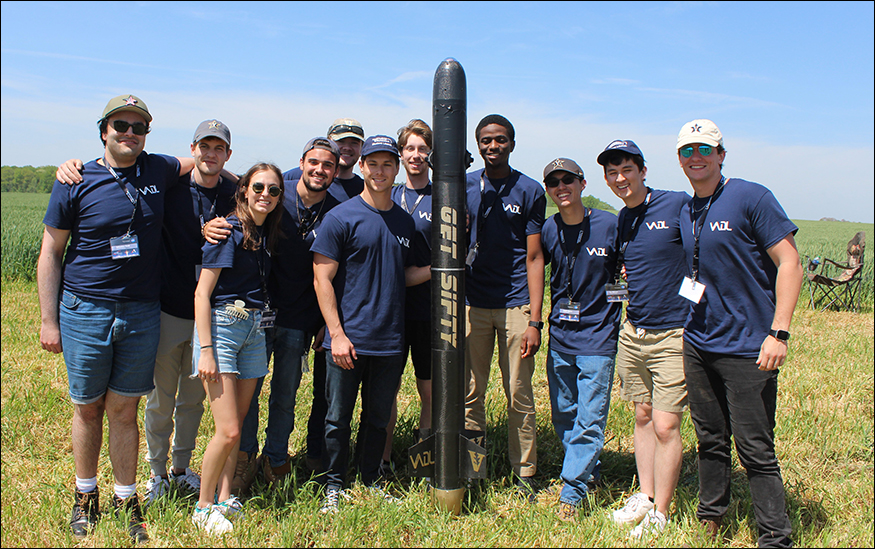
The Vanderbilt rocket team won the coveted NASA Student Launch Project Review Award for the best documentation of the project progress through 2021-2022. The national Student Launch rocketry competition was held in April and results were announced June 3.
This is Vanderbilt’s 15th year to participate in the annual NASA event and teams have won the overall championship seven times and the payload design award eight times.
The Vanderbilt team ranked third in the overall competition this year. Sixty teams from 22 states including Puerto Rico took part in the competition, with 27 teams launching April 23 near NASA’s Marshall Space Flight Center in Huntsville, Alabama. Teams that did not travel were allowed to conduct their final test flights at a home launch field.
The University of North Carolina at Charlotte and University of Notre Dame were first and second place winners, and the University of Florida, Gainesville, and Purdue University rounded out the top five in the launch division.
For this year’s competition, teams were challenged to design a payload capable of autonomously locating the launch vehicle upon landing by identifying the launch vehicle’s grid position on an aerial image of the launch site without the use of a global positioning system (GPS).
“We tackled this problem using scale-invariant feature transform (SIFT) image processing algorithm in conjunction with a camera imaging system with no moving parts. SIFT was activated during the landing phase, at a chosen altitude,” said Ethan Mayer, lead payload designer for the Vanderbilt team.
In real time, key points of the ground features are first extracted from the reference image during the rapid descent and stored in a database. SIFT then continuously compares the subsequent selected images with the original image tracking changes to features while accounting for vehicle translation, rotation, and precession through vector mapping to eventually identify the landing site.
“Our rocket Get Sifty, named appropriately for the payload mission, flew to a height of 4300 ft. on launch day as against 5000ft. Our flight altitude was impacted by the sudden 12 mph side wind gusts right at launch, in addition to the 11 mph steady winds,” said rocket design and field engineer Joseph Aquino. “However, rocket flight was structurally sound, all systems performed nominally enabling optimal payload performance, and the craft was certified ready for re-flight in two hours,” Aquino said.
Comparing SIFT predictions to the satellite-version of the aerial image became difficult as the launch site, Bragg Farms in Toney, Alabama, is not a high-resolution mapping area for Google Satellite Imagery and the changes of the seasons made the ground features different from stock satellite imagery.
SIFT, however, estimated the landing site correctly on launch day based on launch day features. See an onboard camera video and SIFT mapping of landing site.
“As a backup, we also had developed a safe-tested method to measure the wind speed at apogee and through that predict the landing grid. Our relayed landing grid was slightly off because we only examined the steady south-north winds based on weather prediction,” said Ozgur Orun, the team’s aerothermodynamics lead. “The wind gusts during our 90-second rocket launch imposed east-west wind gusts that threw off the modelling. If we had made corrections to our machine learning algorithm to look for winds in both directions, we would have hit the jackpot easily.”
“The final standings were a bit of a letdown considering the overall success of our mission, but our experience will not be diminished because we did not win,” said Zachary Friedman, team captain. “We are immensely proud of our teamwork through the year and the unquestionable clarity of our data analysis and reporting. We are also thankful to have had the opportunity to present the highlights of our program to the Vanderbilt Board of Trust earlier in the spring.”
“Our project challenges have moved from structural engineering, propulsion, and flight dynamics, to incorporate robotics, software integrated systems, and machine learning protocols with the pursuit of overall perfection being the goal,” said Mechanical Engineering Professor Amrutur Anilkumar, director of the Vanderbilt Aerospace Design Laboratory that sponsors the Vanderbilt rocket team annually.
“As engineering is moving to integrate the software side of the house, NASA’s challenges capture that trend well and we have been able to attract students from all the major disciplines at the School of Engineering, making ours a marquee enterprise and we continue to be a big for draw for Vanderbilt,” said Anilkumar.
Contact: Brenda Ellis, 615 343-6314
brenda.ellis@vanderbilt.edu